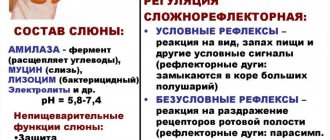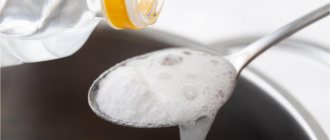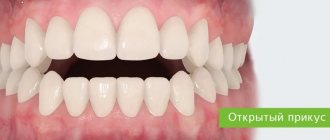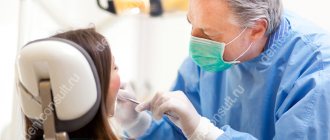Causes of drooling
Physiological factors
The symptom is observed in most women in the first trimester of pregnancy. The appearance of drooling is associated with reflex irritation of the nerve centers that control the production of saliva. The intensity of the manifestations varies: from single nighttime episodes of sialorrhea to constant and uncontrolled flow of saliva, when a woman loses up to 3-5 liters of fluid per day. Drooling is normal in infants and children during the eruption of primary and permanent teeth.
Mechanical irritation of the oral cavity
Hypersalivation, with saliva flowing from the corners of the mouth, is a common problem for people who start wearing removable dentures. Over the course of several months, adaptation to the foreign body occurs, and the amount of saliva released gradually decreases. Short-term sialorrhea is observed during dental procedures, the use of chewing gum or sucking candy. Drooling occurs in many smokers.
Dental diseases
Sialorrhea often develops with stomatitis, gingivitis, and dental caries. The symptom is associated with irritation of M-cholinergic receptors in the mucosa. Drooling is moderate and appears more often at night. During the day, there may be a slight leakage of saliva, which accumulates in the corners of the mouth. In addition to increased salivation, patients complain of soreness and burning in the mouth, pain when chewing and swallowing, and bad breath.
Gastrointestinal diseases
Sialorrhea is possible when the stomach and initial parts of the intestines are affected. Its most typical appearance is in chronic pancreatitis, cholecystitis, and peptic ulcer. The symptom occurs at any time of the day and is often accompanied by heartburn and an unpleasant taste in the mouth. A combination of drooling with abdominal pain, nausea and vomiting, and stool disorders is typical.
ENT diseases
The flow of saliva is typical for people who have difficulty breathing through their nose and sleep with their mouth open. It occurs in patients with sinusitis, chronic rhinitis, and in children with adenoids. Drooling develops primarily during sleep. Due to the constant drying of the mucous membrane, a small amount of viscous saliva is released, accumulating on the skin of the perioral zone or leaving marks on the bed linen.
Worm infestations
The reproduction of helminths in the gastrointestinal tract causes irritation of peripheral receptors, reflexively activating the secretion of saliva. A specific sign of helminthiasis is salivation, which is disturbing at night. A person will know that there is a problem by wet spots on the pillowcase and pajamas. Dried crusts of saliva are visible in the corners of the mouth after waking up. Symptoms are supplemented by abdominal pain, dyspeptic disorders, and itching in the anal area.
Neurological pathologies
The symptom occurs in pathological processes affecting the centers of regulation of salivation. Drooling is one of the first signs of Parkinson's disease, a cerebral tumor. In such conditions, saliva is produced in large quantities and must be constantly swallowed. As problems with swallowing later arise, saliva begins to flow from the corners of the mouth.
Drooling can be caused by impaired innervation of the facial muscles and the inability to completely close the mouth. The manifestation is pathognomonic for facial nerve paralysis and residual effects of a stroke. Saliva always drains from one side of the mouth, where sagging cheek muscles and insufficient lip closure are noted. Drooling increases when a person tilts his head to the side towards the affected side of the face.
In bulbar syndrome, sialorrhea is caused by impaired swallowing and the inability to retain saliva in the mouth. The functioning of the salivary glands remains at the same level or even decreases. Patients feel the saliva present in the mouth, but the automatic act of swallowing does not occur. Drooling is a constant concern, regardless of the time of day. Later, speech disturbances and difficulty swallowing solid and liquid foods appear.
Complications of pharmacotherapy
Most often, salivation increases during treatment with M-cholinomimetics. The drugs affect peripheral receptors and stimulate the functions of the salivary glands. In this case, severe uncontrollable drooling occurs, in which saliva flows copiously down the chin. The symptom is determined from the first days of taking medication. There are other medications that cause drooling:
- Iodine-containing preparations.
- Barbiturates.
- Benzodiazepine derivatives: nitrazepam, phenazepam.
- Neuroleptics: triftazine, haloperidol, moditene-depot, clopixol.
Rare causes
- Congenital forms of drooling
: Glaser syndrome, Cray-Levy syndrome. - Mental illnesses
: schizophrenia, bipolar disorder, catatonic syndrome. - Poisoning
: organophosphorus substances, metals (lead, mercury), poisonous mushrooms and plants. - Hormonal disorders
: hyperestrogenism, menopause, thyroid disease.
Causes of hypersalivation
Most often, excessive salivation occurs against the background of some disease or condition. According to specialists from the Penza dental clinic, possible causes of hypersalivation may include:
- Pregnancy
- Inflammation of soft tissues during teething in children
- Oral infections such as tonsillitis
- Taking certain medications, including tranquilizers and anticonvulsants
- Acid reflux
- Neuromuscular disorders such as Parkinson's disease, stroke and paralysis
Because hypersalivation is often a side effect of more serious problems, you should seek medical help if saliva production is so high that it interferes with normal activities or causes other complications, such as cracked lips, bad breath, dehydration, or difficulty speaking.
Diagnostics
With the problem of drooling, patients turn to a dentist, or less often to a therapist. Given the variety of causes of pathology, the doctor is required to take a detailed medical history and clarify related complaints. The diagnostic search begins with an examination of the oral cavity to identify signs of inflammation or caries. To establish the causes of drooling, the following instrumental and laboratory diagnostic methods are used:
- Biochemical analysis of saliva.
The study evaluates the amount of fatty acid metabolites formed during the life of bacterial flora. Based on the results of the analysis, it is possible to determine the presence of dysbacteriosis and determine the level of damage to the digestive tract. - General clinical studies.
Patients with drooling undergo a general blood test, changes in which indicate the presence of an inflammatory or infectious process. To exclude helminthic infestations, a coprogram is prescribed, a fecal examination for helminth eggs. According to indications, a clinical urine test and studies according to Nechiporenko and Zimnitsky are performed. - Instrumental techniques.
If a patient suffering from drooling has complaints about the functioning of the digestive system, an ultrasound of the abdominal organs and plain radiography are necessary. To exclude neurological diseases, CT or MRI of the brain is recommended. Electroneuromyography is effective for assessing the functions of peripheral nerves.
Treatment
Help before diagnosis
Moderate drooling does not pose a threat to health and does not require emergency treatment. With nocturnal sialorrhea, patients are advised to sleep on their side so that saliva does not enter the respiratory tract. To prevent maceration of the skin around the mouth, you need to maintain hygiene and use nourishing and moisturizing creams. Since there is a risk of dehydration with excessive drooling, you should increase the amount of fluid you drink per day.
To reduce saliva production, doctors advise avoiding sweets, carbonated drinks and foods rich in extractive substances. Hygienic oral care is best done with slightly foaming toothpastes. For swallowing disorders and perioral muscle dysfunction, motor exercises are prescribed to help control drooling. Special massage and physiotherapy are used less frequently.
Conservative therapy
In most situations, drooling can be completely eliminated after treatment of the underlying pathology. The therapeutic regimen is selected by a doctor of the appropriate profile: gastroenterologist, otolaryngologist, neurologist. If drooling is caused by acute poisoning, an intensive detoxification program is carried out in a hospital setting. With massive sialorrhea, pathogenetic therapy is required, which includes:
- M-anticholinergics
. Medicines inhibit the secretion of the salivary glands, quickly eliminating salivation. In addition to standard tablet products, there are skin patches. Solutions with anticholinergics are also used to rinse the mouth. - Tricyclic antidepressants
. An additional effect of medications is a decrease in the functional activity of glandular tissue. They are primarily prescribed for psychogenic salivation. - Botulinum toxin
. Botulinum toxin temporarily blocks the nerve impulses that stimulate salivation. It is used in the form of local injections in the absence of effect from standard conservative treatment.
Increased salivation - causes and features
Increased salivation (hypersalivation) is not always associated with food consumption. In this case, this indicates some disorders in the body. Heavy salivation can be a symptom of various internal diseases. Hypersalivation also occurs in dental pathologies. Therefore, if such a problem occurs, you should consult a dentist.
If the doctor discovers local causes, he will carry out the necessary treatment measures. If there is no dental cause, the dentist will refer you to another specialist for examination.
Features of the violation
Hypersalivation causes discomfort. You can understand that such a problem has arisen by the fact that you have to swallow saliva more often. There is also a constant feeling that there is a lot of it in the mouth.
Increased salivation is often accompanied by other unpleasant symptoms. For example, nausea, heartburn, unpleasant odor. Also, saliva sometimes changes color and becomes thick.
Hypersalivation in some cases is the norm. Excessive salivation is observed during teething, getting used to dentures, and during pregnancy. And, of course, this is the norm during meals.
Such a symptom will indicate a problem if it is present together with other signs.
Main symptoms:
- General malaise.
- Dyspeptic symptoms.
- Discomfort when swallowing.
- Change in taste sensations.
What are the reasons
Causes of hypersalivation include:
- intoxication of the body;
- period after tooth extraction;
- pathologies of the digestive system;
- hormonal disorders;
- problems with blood vessels and the thyroid gland;
- angina;
- menopause;
- stress;
- disorders of the central nervous system.
Treatment and prevention
Treatment varies greatly depending on the cause. Sometimes it is enough to sanitize the oral cavity and cure existing dental diseases. In some cases, it will be necessary to remove the salivary glands.
There are special medications that reduce saliva production. Medicines are prescribed only by a doctor after examination.
To avoid this problem, you need to visit the dentist regularly and treat dental diseases in a timely manner.
It is also important to undergo a general medical examination. It is important to monitor oral hygiene and have tartar removed by the dentist every six months. Giving up bad habits and eating healthy are important preventive measures. Good luck! Tags: increased salivation, hypersalivation, treatment and prevention of increased salivation, treatment and prevention of increased salivation Mosrentgen, treatment of hypersalivation Mosrentgen










